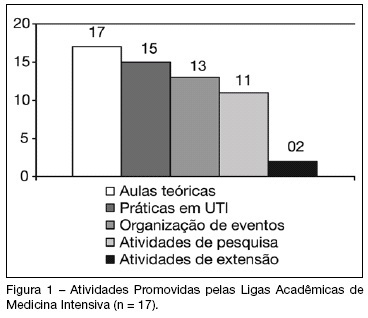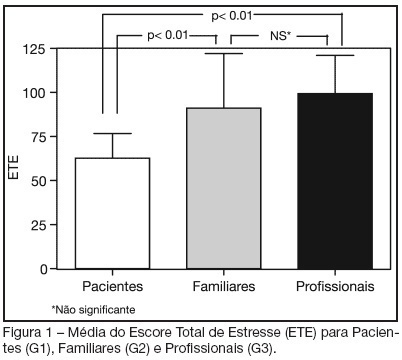Abstract
Rev Bras Ter Intensiva. 2008;20(1):43-48
DOI 10.1590/S0103-507X2008000100007
BACKGROUND AND OBJECTIVES: The Brazilian Intensive Care Medicine Association (AMIB) has been stimulating the creation of undergraduate associations/study groups on Critical Care Medicine (CCM), considering them a useful instrument to fill gaps in professional formation. The aim of this study was to evaluate the activities developed by CCM undergraduate study groups in Brazil. METHODS: The analyzed information was obtained on answers to a standard questionnaire. Contact by e-mail and/or telephone was made with representatives of all study groups registered on AMIB Committee of Undergraduate Study Groups on CCM (LIGAMI-AMIB) in September of 2007. In that period, there were 33 groups associated to LIGAMI, which 4 doesn't exist anymore, 17 answered to the sent questionnaire and the remaining 12 didn't answer the questionnaire or it was not obtained contact. RESULTS: Most study groups were founded after 2005, coinciding with the LIGAMI-AMIB Committee creation, and they are linked to one or more medical schools. Among the group's activities, the most frequent was theoretical classes (100%), usually supplied by teachers or invited physicians (69%). Other activities include practices on Intensive Care Units (88%), organization of scientific events (77%) and research projects (65%). Most study groups (65%) had already organized some scientific event such as courses and symposia; however, only three had already accomplished the AMIB CCM Introductory Course. CONCLUSIONS: The growing number of CCM undergraduate study groups in Brazil demonstrates students' interest for this specialty. Besides, there is a necessity of larger integration between existing groups to change experiences, cooperate in the accomplishment of research projects and participation on national and international events.

Abstract
Rev Bras Ter Intensiva. 2008;20(1):49-56
DOI 10.1590/S0103-507X2008000100008
BACKGROUND AND OBJECTIVES: Norepinephrine and dopamine are used, in the state of shock, with the intention of offering hemodynamic support and to reestablish tissue perfusion. The pharmacological effects of these vasopressors can be diverse, for this reason, their use requires, through the clinician, an interpretation of the hemodynamic effects with observation of the systemic variations and region. With this in mind, the objective of this study was to analyze the publications regarding the effects of norepinephrine and low-dose dopamine in hepatosplenic perfusion and renal in treatment of septic shock. METHODS: Articles were selected (n = 27) concerning the use of norepinephrine and dopamine in septic shock, published during the period of 1997 to September 2007, revised in PubMed, data base of the National Library of Medicine (NLM). The MESH method was utilized with the descriptors norepinephrine, dopamine and sepsis. RESULTS: The effects of dopamine and norepinephrine in kidney perfusion are similar; there is an increase in diuresis and no change in creatinine clearance. Norepinephrine did not affect kidney tissue perfusion in spite of the increase of vascular tone. Regarding the splancnic effects, these drugs showed an increase in blood flow, though redistributing the blood in this compartment. CONCLUSIONS: The best agent for the hemodynamic reestablishment that keeps the adequate regional perfusion remains inconclusive.

Abstract
Rev Bras Ter Intensiva. 2007;19(2):186-191
DOI 10.1590/S0103-507X2007000200008
BACKGROUND AND OBJECTIVES: The adverse effects of intra-abdominal hypertension are known for many years. Only recently proper attention has been given to routine intra-abdominal pressure (IAP) monitoring. There is evidence that a quarter of intensive care units (ICU) do not measure IAP, due to a lack of knowledge of its importance or difficulty in results interpretation. The aim of this study is investigate the knowledge of ICU physicians about abdominal compartimental syndrome and its management. METHODS: A questionnaire with 12 questions about this issue was mailed to ICU physicians. RESULTS: The current knowledge of the international definitions of ACS does not seem to be linked to the number of years of medical practice, but was associated with the time spent working on intensive care. Although most physicians are aware of the existence of ACS, less than half know the present international definitions. The IAP monitoring is performed in patients at risk for ACS, by means of the intravesical filling with 25 to 100 mL of liquids, in intervals varying from of 4 to 8 hours. There was no consensus on the value of IAP values (with or without organ dysfunctions) for the clinical or surgical treatments of ACS in this survey. CONCLUSIONS: The knowledge of ACS is satisfactory when we consider only physicians that devote most of their time to ICU work. However, it is necessary to improve education and knowledge of most intensive care physicians regarding the presence and severity of intra-abdominal hypertension in Rio de Janeiro.
Abstract
Rev Bras Ter Intensiva. 2007;19(1):53-59
DOI 10.1590/S0103-507X2007000100007
BACKGROUND AND OBJECTIVES: The hospital environment, especially in Intensive Care Units (ICU), due to the complexity of the assistance, as well as the physical structure, the noise, the equipments and people's movement, is considered as stress generator for the patients. The aim of this study was to identify and stratify the stressful factors for patients at an ICU, in the perspective of the own patient, relatives and health care professionals. METHODS: A cross-sectional study was carried out between June and November 2004 in a general ICU of a private hospital. The sample was composed of three groups: patients (G1), relatives (G2) and a member of the ICU health care team responsible for the included patient (G3). In order to identify and stratify the stressful factors, we used the Intensive Care Unit Environmental Stressor Scale (ICUESS). For each individual, a total stress score (TSS) was calculated from the sum of all the answers of the scale. RESULTS: Thirty individuals were included in each group. The mean age of the three groups was: 57.30 ± 17.61 years for G1; 41.43 ± 12.19 for G2; and 40.82 ± 20.20 for G3. The mean TSS was 62.63 ± 14.01 for the patients; 91.10 ± 30.91 for the relatives; and 99.30 ± 21.60 for the health care professionals. The patients' mean TSS was statistically lower than mean TSS of relatives and professionals (p < 0.01). The most stressful factors for the patients were: seeing family and friends only a few minutes a day; having tubes in their nose and/or mouth; and having no control on oneself. CONCLUSIONS: The perception of the main stressful factors was different among the three groups. The identification of these factors is important to the implementation of changes that can make the humanization of the ICU environment easier.
